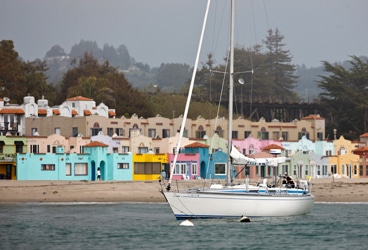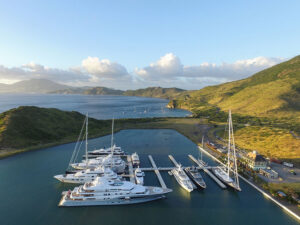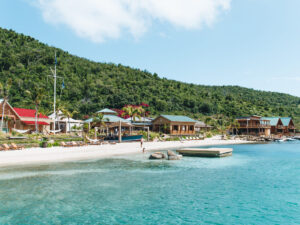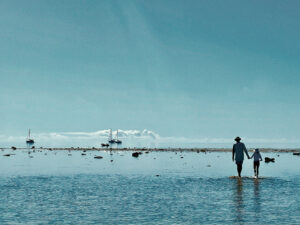
Capitola
California is home to 38 million people, but here we are, just a mile off the beach, and we’re utterly alone. There isn’t another boat in sight. When Anton Muzik and I departed from Sausalito at midday on a Saturday aboard his Swan 391, Zeus, San Francisco Bay was cluttered with scores of sailboats. Two of them headed out under the Golden Gate with us. One turned back at Mile Rock; the other, a TP52, rounded the corner heading south, then quickly disappeared over the horizon, leaving us sailing alone, as if we were off the desolate shore of an unpopulated land.
As Anton and I set out on our harbor-hopping way down the central California coast, the numbers suggest that we should have had plenty of other pleasure boats joining us to do the very same thing: More than 7 million people live in the vicinity of San Francisco Bay, and the number of slips in the Central Bay exceeds 11,000. Most of them are filled with boats capable of making the same journey that we’re undertaking. It’s true that harbors on every coast contain a majority of boats that rarely, if ever, venture more than 10 miles from home, but still, this seems to be an extreme case. Very few boats cruise along the central California coast, and it begs the question: Why?
It’s true that California offers a coastline of few harbors. Thanks to its geological inheritance, the state presents a blunt face to the Pacific, one that’s long, straight, and stands tall. There are some stretches, both north and south, completely lacking a decent place for a sailor to tuck into. However, this central part of the coast features several good harbors with safe entrances, plenty of guest slips, and warm showers.
Perhaps, then, it’s the sea conditions that intimidate sailors and prevent them from venturing out for some coastal cruising? Richard Henry Dana sailed here in 1835 during the voyage that he describes in Two Years Before the Mast, in which he writes: “A painter could not have painted so clear a sky. There was not a speck upon it. Yet it was blowing great guns from the northwest. When you can see a cloud to windward, you feel that there is a place for the wind to come from, but here, it seemed to come from nowhere.” Indeed, it’s a statement that seems to dominate the impression that many modern mariners have of the area. And let them think that it’s an unyielding truth, for it keeps the snarl of traffic on the roads and the clutter of boats inside the bay, and it leaves some spectacular cruising grounds relatively untouched.
In fact, the sailing conditions aren’t quite so bad as reputation would have it, and if you take the time to pick your days, there are plenty of opportunities to sail in fair wind. During the spring months, it may blow a cool, clear gale out of the northwest for a day or two, but it’s just as likely to draw warm, damp southerlies with showers or light and variable zephyrs with dense fog. Anton and I made our trip over a two-week period in April, and we saw it all.
Reaching south under clear skies with 25 knots over the starboard quarter, we arrive at Pillar Point Harbor, in Half Moon Bay, well before dinnertime. We eat at Ketch Joanne, the focal point of the docks here, which opens at 6:30 a.m., when it fills with the fishermen who dominate this harbor and define its character. Like most harbors in California, Pillar Point is home to a small number of derelict-looking plywood trimarans as well as some perfectly seaworthy-looking yachts, but the many fishing boats here come in all shapes and materials, including wood, steel, and fiberglass. The fishermen catch crab, salmon, albacore, halibut, sardines, and squid. While it’s only a short drive north to San Francisco and a short drive east to Silicon Valley, the nearby city of Half Moon Bay nevertheless retains a small-town feel that stands in stark contrast to the urban crowds that we left behind in San Francisco.
In the morning, we’re greeted by a marine layer that obscures the sun. The wind blows at five to 10 knots out of the northwest. It’s cold enough that we dress in long johns and fleece under our foul-weather gear, the standard uniform when one sails off the coast here, where the water temperature hovers year-round in the 50s F. We keep that gear on when the skies eventually clear because the wind picks up to 25 knots out of the northwest, and the air is still cool. After about 50 miles of sailing, we round the corner on our way into Santa Cruz, the next harbor south. As we come into the lee of the land, we immediately begin shedding layers. We can see kids splashing in the small waves at the crowded beach and pedal-powered boats idling around in the near-glassy calm outside the harbor entrance.
Santa Cruz is distinctly California, and while you might get away with saying that San Franciscans are like New Englanders living in a town with palm trees, you could never say that about Santa Cruz. The clusters of surfers standing up on the cliffs watching the waves break, the shuffling hippies who smell like patchouli, the homeless kids socializing between stints of panhandling on Pacific Avenue, the teenage couples strolling past the Beach Boardwalk amusement park: All are Californian to the core. Wherever they may have come from originally, in this town they’re Californians, and on a sunny, 75 F Sunday evening, they’re all outside, and you couldn’t mistakenly locate this scene in any other state.
In the morning, after bobbing around in the kelp to watch surfers ride waves, we unclog our raw-water intake and steam through the fog for a couple of miles to pick up a mooring off the beach town of Capitola. It’s a pleasant little town of bright colors and small buildings set close to the beach, definitely a nice place at which to enjoy lunch. Afterward, we strike out for Monterey. We cross Monterey Canyon, where the depth sounder spins complete circles again and again. We know from the chart that it bottoms out at 2,000 feet here and reaches down to depths of more than two miles farther offshore. The water is as black as it should be over an abyss. Once out of the lee of the land, the wind comes over our starboard quarter at more than 30 knots, and it takes no time for us to arrive.
Monterey is dominated by tourists, and although Cannery Row, today clogged with T-shirt shops, is much more interesting when seen through the eyes of Steinbeck or captured in the old photographs at the Monterey History & Maritime Museum, the Monterey Bay Aquarium offers a chance for Anton and me to see some of the creatures over which we’ve just sailed, such as schools of tuna and the wolf eels that live in the kelp forests. Walking a couple of miles along the shore from the harbor to Lovers Point Park, in nearby Pacific Grove, I see otters floating on their backs and harbor seal pups napping on the beach. It’s easy to feel like you’re on vacation here.
Impulsively, we decide to add another day of sailing and point Zeus toward Carmel-by-the-Sea. While there are no decent anchorages or a harbor there, the trip makes for a spectacular day of sightseeing: Views of the Pebble Beach golf course and its groomed fairways appear just above Pacific breakers, and we catch glimpses of the Spanish-looking Carmelite Monastery set among palm trees above a beach and beneath a mountain.
Eventually, it’s time to sail back up the coast to San Francisco, and on the 50-mile leg from Santa Cruz to Half Moon Bay, we get a taste of why it is, perhaps, that so few boats cruise on these waters. The lighthouse at Pigeon Point, ruggedly attractive, set against green hills, and surrounded by blooming flowers, is certainly worthy of a good look. But for the past four hours, it’s served to drive home just how poor our V.M.G. is. Beating into 25 knots of wind with a single reef in the main and tacking through 105 degrees limits our progress to the pace of a brisk walk. We’ve been staring at the light’s 115-foot tower for far too long.
The truth is that if it weren’t for the limitations imposed by scheduling, we could’ve mitigated the circumstances of our one long beat by just delaying our return trip by a day; as it is, we’ve only added a few hours of sailing time to our trip. The effect, however, is to make us feel as if we’ve earned all the great unspoiled sailing that we’ve experienced.
When we coast in under the Golden Gate on a Sunday afternoon and see all the boats out chasing each other around buoys while we’re shedding safety harnesses and foul-weather gear, I feel like I’ve been on a great voyage and that I’m seeing the small world I left behind through new eyes. I know that you could drive to the farthest point that we reached on our trip in less than three hours, but I’ll still claim our adventure as a rare journey to the back of beyond.
Abner Kingman, a journalist who lives outside of San Francisco with his wife and two children, 6 and 3, is spending a lot more time these days getting to know areas close to home.








